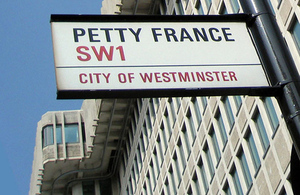- transport ministers from both nations sign a historic joint action plan to help rebuild Ukraine’s transport network
- Department for Transport offers funds, engineering expertise and vehicles
- UK support for Ukraine now nearly £4 billion
The UK has signed a historic pact with Ukraine that commits to sharing engineering expertise and pledges a new package of support to help rebuild its war damaged infrastructure.
Transport Secretary, Grant Shapps, today (25 June 2022) hosted a virtual meeting with his counterpart at the Ministry of Infrastructure, Oleksandr Kubrakov, in the same week Ukraine marked its Independence Day and 6 months since Putin’s barbaric and illegal invasion of their country.
After a presentation from Ukrainian officials on the true impact of the war to their train network, roads and bridges, the two transport leaders signed a joint action plan to help restore these vital links. It agrees to share expert advice from prestigious UK-based private-sector organisations. The UK will also send 5 buses from the Go Ahead Group to support reconnecting the Ukrainian public and buy equipment to repair routes which are crucial for the exportation of grain.
Experts will offer knowledge in airport, runway and port reconstruction, and will work with the Ministry of Infrastructure to identify training opportunities for airport staff, air traffic controllers and aviation security.
The Transport Secretary also outlined more detail about the £10 million Ukrainian Railways support package, previously announced by the Prime Minister at the G7 Summit. This will buy bridge repair and tunnel lining equipment, key hand tools and more than 120 shipping containers, which will help mobilise Ukrainian grain trains, currently hampered by Russian activity. With Ukraine being one of the biggest exporters of grain in the world, these vital interventions will help its economy recover and alleviate pressure on global food prices.
This will support the Black Sea Grain Initiative, which allows the safe passage of grain, food and fertiliser exports out of Ukraine in protected shipping corridors. So far, the initiative has freed 721,449 metric tons of goods from 3 Ukrainian ports.
Transport Secretary Grant Shapps said:
It’s great to meet with the Ukrainian Infrastructure Minister today and offer the UK’s expertise and resource to help them rebuild and get its people get moving again in the face of this brutal conflict.
In the UK we have some of the best transport experts in the world and sharing this with Ukraine will not only help them rebuild – but will boost the profile of UK businesses on a global scale.
Earlier this year, the UK assumed presidency of the International Travel Forum (ITF) and committed to bring global partners together in solidarity against the invasion of Ukraine. Under the UK presidency the ITF will launch new dedicated research into the impact of the war on transport and will share constructive policy advice on the sustainable reconstruction of its infrastructure.
Ukrainian Minister for Infrastructure, Oleksandr Kubrakov said:
The fate of war is decided not only on the battlefield. Ukraine needs a strong economy and steadily operating infrastructure.
Thanks to today’s agreements, we expect to receive high-quality expertise from leading British companies and institutes to restore Ukrainian infrastructure.
I am grateful to my colleague, the Transport Secretary, for Great Britain’s comprehensive support of Ukraine’s fight against Russian aggression.
This government is working tirelessly to help the Ukrainian people in their fight against Russia, with the total value of UK support now standing at nearly £4 billion through multilateral loan guarantees and over £100 million bilateral support.
This government has introduced the largest and most severe package of sanctions ever imposed on Russia, or indeed any major economy. We have sanctioned over 1000 individuals, 100 businesses, and cracked down on Russian-owned yachts and private jets, costing oligarchs £117 billion.
